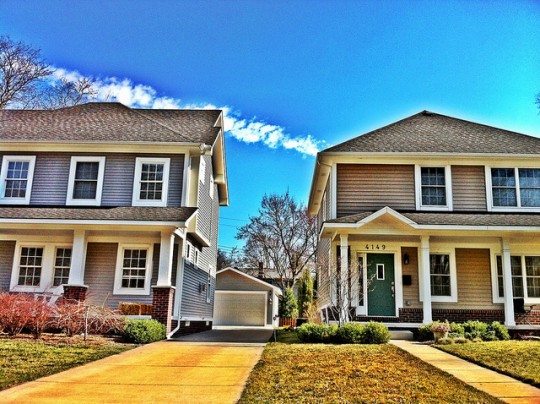Following the government shutdown in October, Americans’ confidence in the economy tumbled. But ever since that plunge, confidence has been slowly returning. And according to Gallup’s most recent Economic Confidence Index, Americans’ assessment of current economic conditions has almost completely rebounded to levels last seen in mid-September. On the other hand, the index component measuring future outlook, which took a heavier hit during the shutdown, remains 11 points below mid-September levels – though it has recovered 24 points since its post-shutdown low. Gallup’s report says economic confidence should be more positive than negative next year, as long as home and stock prices keep rising and the job market continues to improve. More here.
Archive for December 2013
Housing Gradually Recovering Lost Ground
Housing markets across the country are gradually recovering and even exceeding previous normal levels of economic and housing activity, according to the latest Leading Markets Index from the National Association of Home Builders. The NAHB scores more than 350 metro areas by taking their average permit, price, and employment levels for the past 12 months and dividing it by their annual average during the last period of normal growth. Based on that score, the index ranks markets that have reached or surpassed their previous normal level. The most recent release found 55 housing markets operating at or above their previous norm. Nationwide, the housing market was at 85 percent normal growth. Rick Judson, NAHB’s chairman, said the index shows that most housing markets across the country are continuing a slow, gradual climb back to normal levels. There were more than 125 markets showing activity of at least 90 percent of their previous norm. More here.
Housing Market Returns To Normal In 2014
Despite an up-and-down recovery, the housing market will enter 2014 more normal than it was a year earlier, according to a recent article from Trulia’s chief economist, Jed Kolko. Kolko says home price and mortgage rate increases have led to declining investor activity, which will inevitably result in less competition for potential buyers in the new year. And, though affordability levels have fallen – according to recent data -buying a home is still 35 percent cheaper than renting and a less frenzied market should be more inviting to prospective buyers. Also, next year will see increases in available inventory as the number of underwater homeowners continues to fall, which will help moderate price gains. Kolko believes repeat buyers will dominate the market in 2014, as investor activity tails off. Repeat buyers are less discouraged by higher prices than first-time buyers or investors, due to the fact that their existing home has likely also risen in value. More here.
Mortgage Demand Rises After Holiday Week
According to the Mortgage Bankers Association’s Weekly Applications Survey, mortgage loan activity rose following a slow week that included the Thanksgiving holiday. The MBA’s Market Composite Index – which measures both purchase and refinance activity – found the number of people requesting applications for mortgage loans increased 1 percent from the previous week on a seasonally adjusted basis. Refinance demand rose 2 percent, bringing the refinance share of total mortgage activity to 65 percent. Purchase demand was up 1 percent. Also, the average contract interest rate for a 30-year fixed-rate mortgage increased last week. The average interest rate is now the highest it’s been since September. More here.
Gov’t Scorecard Finds Progress in Housing
New Home purchases and home prices remain strong while foreclosures continue to fall, according to the November edition of the federal government’s housing scorecard. The monthly scorecard collects key housing data and the results of the administration’s recovery efforts. Released by the U.S. Department of Housing and Urban Development and the U.S. Department of the Treasury, the most recent scorecard finds progress in the housing market, though officials caution that the overall recovery remains fragile. Still, according to the report, housing affordability remains above historical norms, despite rising prices and mortgage rates. Kurt Osowski, HUD’s deputy assistant secretary for economic affairs, said continuing growth in the economy and job market, along with rising home prices, have combined to reduce foreclosure starts to levels not seen since 2005. More here.
Americans Cautious But Still Want To Buy
Americans are feeling cautious about their money and the housing market as 2013 comes to an end. Surveyed for Fannie Mae’s November National Housing Survey, nearly two-thirds of Americans said they believe the economy is headed in the wrong direction and that their personal finances will worsen in the next year. Despite the pessimism, however, the housing market is still expected to improve. Doug Duncan, senior vice president and chief economist at Fannie Mae, said caution is the defining feature of Americans’ attitudes toward the economy. In this environment, according to Duncan, the housing market is likely to improve but only at a gradual pace. Still, a majority of Americans said they would buy, rather than rent, if they were to move and 64 percent feel that now is a good time to buy a home. The number of respondents who felt it would be easy for them to obtain a home mortgage rose 4 percentage points to 50 percent. More here.
Fed Report A Mixed Bag On Housing Market
The Federal Reserve’s Beige Book tracks economic activity across the country based on reports from the Fed’s 12 districts. The report focuses on a number of economic sectors, including manufacturing, consumer spending, agriculture, employment, banking, and real estate. According to the most recent release, residential real-estate activity improved in many areas, while remaining steady or softening in others. Home sales remain largely above year-ago levels, though there was some slowing as the summer sales season wrapped up. Increasing demand, declining levels of inventory, and rising new-home construction were cited by the report as the reason behind continuing home price increases, though prices are increasing at a slower pace now than in early 2013. Lower residential mortgage activity was also reported in many district but several saw better credit quality as delinquencies decline and fewer problem loans are reported. More here and here.







